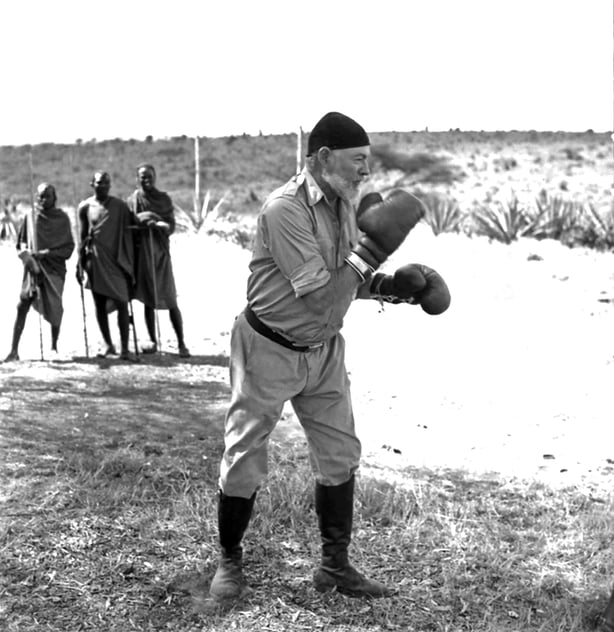Opinion: both Across the River and Into the Trees and The Garden of Eden are novels which challenge the stereotypical style of the writer
While Ernest Hemingway may very well be"'America's most famous author', it seems that his public image was, and still is, far from the actual man. What usually comes to mind is (toxic) masculinity, braveness, literary success, bull fights and alcoholism. These stereotypes are perfectly illustrated in Woody Allen's 2011 film Midnight in Paris, in which we can see a drunk and flirty Hemingway trying to get into a fight.
While this representation is undoubtedly based on real events, it also limits who Hemingway really was. Most importantly, it conditions the way we read his work. In fact, novels that challenged the stereotypical Hemingway style have been completely forgotten and disregarded.

It is true that the works which received most attention, such as The Sun Also Rises (1926), A Farewell to Arms (1929), and For Whom The Bells Toll (1940), all feature straight handsome white men characterised by their fearlessness and flirtiness with women. Sometimes, flirting is all they can do, as some male characters turn out to be impotent. The Old Man and the Sea (1952) is the exception to the rule yet still features some of Hemingway’s predilections: hunting and killing.
But if one looks closely at his work, two novels need to be paid more attention to: Across the River and Into the Trees, written in 1951, and The Garden of Eden, published posthumously in 1986. Across the River and Into the Trees takes place in Venice. Although the novel was a bestseller when it was first published, it quickly disappeared into oblivion. The plot is strikingly close to Hemingway’s life in 1951: a 50-year old man falls in love with an 18-year old Venetian girl. The older man is in a poor health state and has several war injuries; the young woman is beautiful and flawless.
We need your consent to load this rte-player contentWe use rte-player to manage extra content that can set cookies on your device and collect data about your activity. Please review their details and accept them to load the content.Manage Preferences
From RTÉ Radio 1's Arena, Declan Hughes discusses the six-part documentary series on Hemingway by Ken Burns and Lynn Novick
When Hemingway wrote the novel, he was himself suffering from mental and physical illnesses and his alcoholism was at an advanced stage. The Venetian woman is inspired by Adriana Ivancich, with whom Hemingway fell in love when he was married to his last wife. She was much younger than him and was from a wealthy family in Venice. Critics and biographers agree that Ivancich rejected Hemingway romantically, but still, they remained friends and spent time together in Cuba, along with Hemingway's wife.
But why does no one remember this novel? Its themes are not that different from his other works yet, the novel reads very differently from the others. First of all, it is based on the old man’s obsession with his coming death - and, spoiler alert - he does die at the end of the novel. The whole novel is highly nostalgic. Far from being glorified, the main character is shown with all of his flaws and depicted like an old ill man having his last fling. Unlike Hemingway’s other heroes, the character is not embellished whatsoever and what characterises him is his vulnerability.

The similarities between Hemingway's own life and the novel also went against his public image: Hemingway was not seen as vulnerable and weak, so a novel displaying these themes was unusual and damaged his reputation. Forgetting the novel was easier than changing one’s preconceptions.
The other forgotten novel, The Garden of Eden, was actually more than disregarded and its access was censored for years because of its sulphurous content. Hemingway started writing it in 1946, a few years before Across the River and Into the Trees, but only finished it 15 years later. It was then published long after Hemingway’s death.
Trailer for John Irvin's 2010 film The Garden of Eden based on Hemingway's novel
The novel features a couple who participates in gender role inversions, especially during sexual intercourse. It explores queer and crossdressing themes as the wife asks to be called "Peter", changes her physical appearance (by cutting her hair short, for instance), and dominates her husband in bed.
The Garden of Eden was kept hidden in the archives in Hemingway's collection at the Kennedy Library in Boston. Astoundingly, some scholars and biographers kept it hidden until the 1990s, and another less explicitly transgressive version was even published. The novel was eventually rehabilitated, but is nowadays only studied in queer studies curricula, considerably limiting its audience. Ask any English students about it and they are sure to have never heard of it - or of that side of Hemingway as a matter of fact.
We need your consent to load this rte-player contentWe use rte-player to manage extra content that can set cookies on your device and collect data about your activity. Please review their details and accept them to load the content.Manage Preferences
From RTÉ Radio 1's Sunday Miscellany, Brian Leyden on reading the work of Ernest Hemingway, 60 years after his death
The disappearance of Across the River and Into the Trees and The Garden of Eden from the public's consciousness are perfect examples of how we construct a public figure's image. Hemingway was seen as the symbol of whiteness, male power, and heteronormativity during his lifetime, and even long after. He unsuccessfully tried to break away from this public image, but it is about time we get to see him for who he really was - and he may be more interesting than we thought he was.
The views expressed here are those of the author and do not represent or reflect the views of RTÉ





